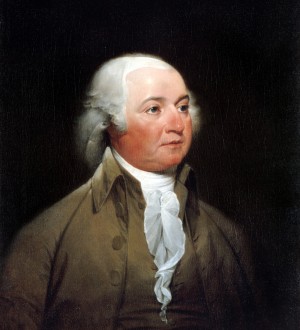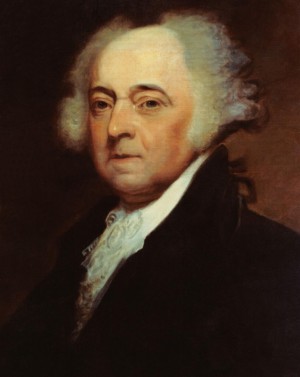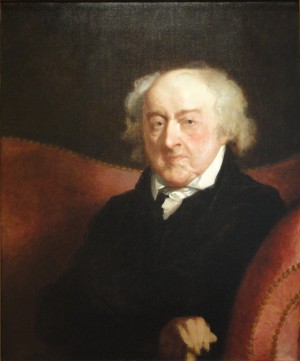Tiền nhiệm George Washington
Kế nhiệm Thomas Jefferson
Đảng Đảng Liên bang
Sinh 30 tháng 10, 1735
Nghề nghiệp Luật sư
Phu nhân Abigail Smith Adams
John Adams, Jr. (30 tháng 10 năm 1735 – 4 tháng 7 năm 1826) là Phó tổng thống đầu tiên của Hoa Kỳ (1789–1797) và là Tổng thống thứ 2 của Hoa Kỳ (1797–1801). Ông đã bị thua trong lần tranh cử tổng thống tiếp theo vào năm 1800 bởi Thomas Jefferson- người kế nhiệm ông. Adams cũng là tổng thống đầu tiên được ở tại Nhà Trắng mới xây dựng ở Washington, D.C. và việc xây dựng được hoàn thành vào năm 1800.
Adams là người đỡ đầu cho Cách mạng Mỹ ở Massachusetts. Ông là một trong những người dẫn hướng cho sự độc lập năm 1776; Jefferson gọi ông "Người khổng lồ của Nền độc lập". Ông là đại diện cho Đại hội Liên bang ở Châu Âu.
[sửa]Đời sống
 Nơi sinh của John Adams ở Quincy, Massachusetts
Nơi sinh của John Adams ở Quincy, Massachusetts
John Adams sinh ngày 30 tháng 10 năm 1735 tại Braintree, Massachusetts, là anh cả trong gia đình có 3 anh em. Nơi sinh của ông hiện nay là một phần của Công viên Lịch sử Quốc gia Adams. Cha của ông là một chủ trang trại có cùng tên John (1690-1761), ông là thế hệ thứ 4 của Henry Adams, một người nhập cư từ Somerset Anh tới Massachusetts vào năm 1636. Mẹ của ông là Susanna Boylston Adams[1].
Adams vào Đại học Harvard khi 16 tuổi (năm 1751). Cha ông mong ông trở thành một bộ trưởng nhưng ông không tin như vậy[2]. Sau khi tốt nghiệp vào năm 1755, ông dạy học một vài năm tạiWorcester, khoảng thời gian để ông suy nghĩ về việc chọn nghề. Sau thời gian dài suy nghĩ, ông quyết định trở thành một luật sư, và nghiên cứu về luật trong một văn phòng của James Putnam, một luật sư có tiếng ở Worcester.
Năm 1764, Adams cưới Abigail Smith (1744–1818), họ có sáu người con: Abigail (1765-1813);John Quincy (1767-1848) sau cũng trở thành tổng thống; Susanna (1768–1770); Charles (1770-1800); Thomas Boylston (1772-1832); và Elizabeth (1775) chết sau khi sinh.
John Adams Biography

John Adams by John Trumbull, c. 1792-93
Born on October 30, 1735, Adams was the first Vice President of the United States and the second President of the United States. His son,John Quincy Adams , was the sixth President of the United States.
Early Life
Adams was born in the town of Quincy, Massachusetts, to John Henry Adams and Susanna Boylston Adams. He graduated from Harvard College in 1755, taught at Worcester and studied law with Rufus Putnam, to be admitted to the bar in 1758.
A writer at heart, Adams often wrote about various events and happenings in his world. In his early years his writings included a report of the argument of James Otis in the superior court of Massachusetts, and in his later years he wrote several memoirs, recollections and arguments based on his earlier writings.
Politics
Adams was practically the opposite of George Washington in terms of personality. Where Washington was outgoing and community minded, Adams was known to be impetuous, intense and often vehement.
Adams political career began when he was became the leader of the Massachusetts Whigs, during which time he drafted what would become the instructions from towns to their state representatives. In 1765, he penned a series of controversial articles in which he argued that the opposition of the colonies to the Stamp Act was part of the never ending struggle between individualism and corporate authority.
In 1768, Adams moved to Boston and in 1770 he helped defend several British soldiers who were arrested after the Boston Massacre. His outstanding defense of the soldiers – which resulted in their acquittal – was a key to his being elected to the Massachusetts House of Representatives.
John Adams was a member of the Continental Congress from 1774 to 1778. In June, 1775, with a view to promoting the union of the colonies, he seconded the nomination of Washingtonas commander-in-chief of the army. His influence in congress was great, and almost from the beginning he was impatient for a separation of the colonies from Great Britain.

John Adams by Asher B. Durand
In 1778 John Adams sailed for France to supersede Silas Deane in the American commission there. But just as he embarked that commission concluded the desired treaty of alliance, and soon after his arrival he advised that the number of commissioners be reduced to one. His advice was followed and he returned home in time to be elected a member of the convention which framed the Massachusetts constitution of 1780, still the organic law of that commonwealth. With James Bowdoin and Samuel Adams, he formed a sub-committee which drew up the first draft of that instrument, and most of it probably came from John Adams’s pen.Furthering his colonial ambitions, Adams seconded a resolution that these colonies are, and of a right ought to be, free and independent states. As a direct result he was appointed the next day – on June 8, 1776, to a committee with Jefferson, Franklin, Livingston and Sherman to draft the Declaration of Independence. In fact, Adams became the most vocal member of the committee and pushed the hardest for its adoption.
Adams next became heavily involved in the negotiations of peace with Great Britain, working alongside Franklin, Jefferson, Jay and Henry Laurens. Circumstances were such that ultimately the only two negotiators, of the 5, that were present were Adams and the pliant John Jay. As a result, Adams’ belief that the United States should receive certain favorable allowances, such as rights to the fisheries along the British-American coast, was well received. In fact, the negotiations went so well that the treaty was signed well ahead of schedule, on November 30, 1782.
While in Europe, Adams argued convincingly for the rights of the state governments. In the process, he offended many of his countrymen back home with sentences such as ‘the rich, the well-born and the able’ should be set apart from other men in a senate. As a result, while Washingtonreceived every electoral vote, Adams received only 34 out of 69 – thus making him the second most popular candidate and therefore the Vice President.
Presidency
In 1796, after Washington refused to seek another term, Adams was elected president, defeating Thomas Jefferson – who became the Vice President by virtue of having the second most electoral college votes. Adams’s four years as president (1797-1801) were marked by a succession of intrigues which embittered all his later life. The passage of the Alien and Sedition Acts eventually brought discredit on the Federalist party. Moreover, factional strife broke out within the party itself; Adams and Hamilton became alienated, and members of Adams’s own cabinet virtually looked to Hamilton rather than to the president as their political chief.

John Adams by Gilbert Stuart, 1826
In 1800, Adams was again the Federalist candidate for the presidency, but the distrust of him in his own party, the popular disapproval of the Alien and Sedition Acts, and the popularity of his opponent, Thomas Jefferson, combined to cause his defeat. He then retired into private life.
Later Life and Legacy
Adams was, at his core, an author, communicator and defender – often arguing unpopular opinions merely to see if he could bend his mind to the task in such a way as to unnerve his opponents and ultimately win the day.
While these traits served him well in his state roles and his representation of the United States during the British peace treaties they were ultimately his downfall as a President.
On July 4, 1826, on the fiftieth anniversary of the adoption of the Declaration of Independence, he died at Quincy, after uttering the famous last words “Thomas Jefferson still survives.” (Unbeknownst to Adams, Thomas Jefferson had died a few hours earlier).




Không có nhận xét nào:
Đăng nhận xét